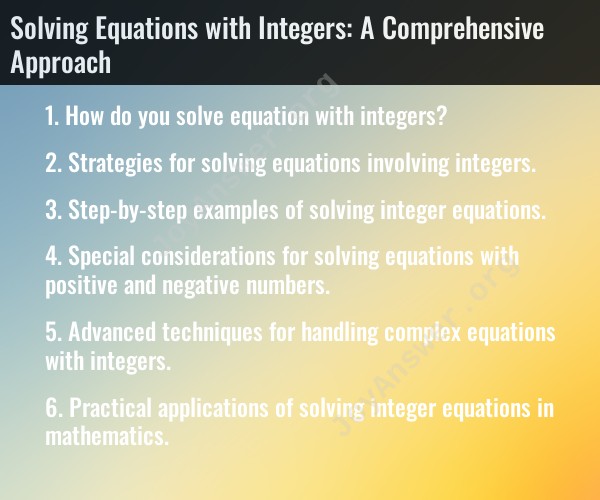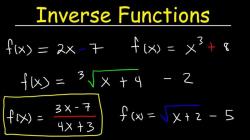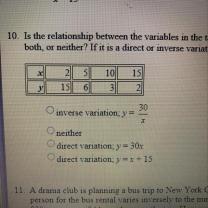How do you solve equation with integers?
Solving equations with integers is similar to solving equations with real numbers, but it involves working with whole numbers, both positive and negative. Whether you're dealing with simple one-step equations or more complex equations, the general approach remains the same. Here's a comprehensive guide on how to solve equations with integers:
Step 1: Understand the Equation
- Carefully read and understand the equation, identifying the variable (typically represented by a letter, such as ), constants, coefficients, and operations (addition, subtraction, multiplication, division, etc.).
Step 2: Isolate the Variable
- Your goal is to isolate the variable on one side of the equation. To do this, perform operations on both sides of the equation to simplify and isolate the variable.
Step 3: Perform Operations
- Perform inverse operations to isolate the variable. If an operation is applied to one side of the equation, apply the same operation to the other side to maintain equality. Common inverse operations include:
- Addition and subtraction (adding or subtracting the same value to both sides)
- Multiplication and division (multiplying or dividing both sides by the same value)
Step 4: Simplify
- Simplify the equation as you perform operations. Combine like terms and follow the order of operations (PEMDAS/BODMAS) when necessary.
Step 5: Check for Extraneous Solutions (if applicable)
- After simplifying the equation, check for extraneous solutions if you've applied operations like taking square roots or other non-linear functions. Extraneous solutions are those that do not make the original equation true when substituted back in.
Step 6: Solve for the Variable
- Continue isolating the variable until it's on one side of the equation by itself. This is the solution to the equation.
Step 7: Express the Solution
- Express the solution as an integer or a set of integers, depending on the equation. The solution may be a single number, a range, or a set of numbers that satisfy the equation.
Step 8: Check the Solution
- Substitute the solution back into the original equation to verify that it makes the equation true. If it does, the solution is confirmed as correct.
Step 9: Finalize the Solution
- Review your work to ensure the equation has been solved accurately. Be aware of any special cases or restrictions that may apply to the variable.
Step 10: Express the Solution in Plain Language (if necessary)
- If you need to explain the solution in everyday language or in the context of a problem, do so for clarity.
Here's an example of solving a simple linear equation with integers:
Example: Solve the equation .
Step 1: Understand the Equation.
- Variable:
- Constants: 7 and 10
- Coefficient: -3
- Operations: Addition and subtraction
Step 2: Isolate the Variable.
Step 3: Perform Operations.
Step 4: Simplify.
Step 5: Check for Extraneous Solutions.
- Not applicable in this case.
Step 6: Solve for the Variable.
- Variable is already isolated.
Step 7: Express the Solution.
Step 8: Check the Solution.
- Plug back into the original equation: , which is true.
Step 9: Finalize the Solution.
- Review the work to ensure accuracy.
Step 10: Express the Solution in Plain Language.
- The solution is , which means that when is -1, the equation is true.
Strategies for solving equations involving integers
There are a number of strategies that can be used to solve equations involving integers. Some common strategies include:
- Using the order of operations: The order of operations is a set of rules that determines the order in which mathematical operations are performed in an equation. By following the order of operations, you can avoid making mistakes when solving equations.
- Combining like terms: Like terms are terms that have the same variables and exponents. By combining like terms, you can simplify equations and make them easier to solve.
- Isolating the variable: To isolate the variable, you need to get it by itself on one side of the equation. You can do this by adding or subtracting numbers and terms to both sides of the equation.
- Solving for the variable: Once you have isolated the variable, you can solve for it by dividing both sides of the equation by its coefficient.
Step-by-step examples of solving integer equations
Here are some step-by-step examples of solving integer equations:
Example 1: Solve the equation x + 3 = 7.
Solution:
- Subtract 3 from both sides of the equation:
x + 3 - 3 = 7 - 3
- Simplify:
x = 4
Example 2: Solve the equation 2x - 5 = 11.
Solution:
- Add 5 to both sides of the equation:
2x - 5 + 5 = 11 + 5
- Simplify:
2x = 16
- Divide both sides of the equation by 2:
2x / 2 = 16 / 2
- Simplify:
x = 8
Special considerations for solving equations with positive and negative numbers
When solving equations with positive and negative numbers, it is important to keep track of the signs. When you add or subtract numbers with different signs, the sign of the result will depend on the signs of the numbers being added or subtracted.
For example, if you add a positive number to a negative number, the result will be negative. If you subtract a positive number from a negative number, the result will be positive.
Advanced techniques for handling complex equations with integers
There are a number of advanced techniques that can be used to handle complex equations with integers. Some common advanced techniques include:
- Factoring polynomials: Factoring polynomials can be used to simplify equations and make them easier to solve.
- Completing the square: Completing the square can be used to solve quadratic equations.
- Using the quadratic formula: The quadratic formula can be used to solve quadratic equations that cannot be factored.
Practical applications of solving integer equations in mathematics
Solving integer equations has a number of practical applications in mathematics. For example, integer equations can be used to:
- Solve word problems involving integers.
- Solve mathematical problems involving integers, such as finding the greatest common divisor or least common multiple of two integers.
- Prove mathematical theorems.
- Develop and analyze mathematical algorithms.
Overall, solving integer equations is an important skill in mathematics that has a wide range of applications.













